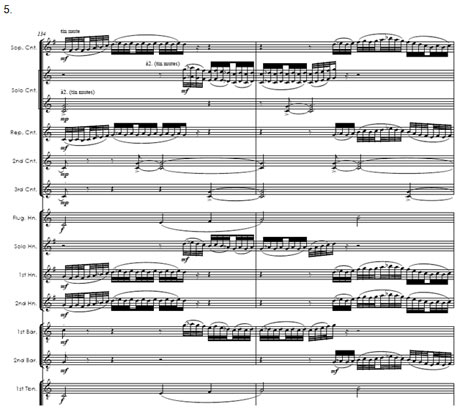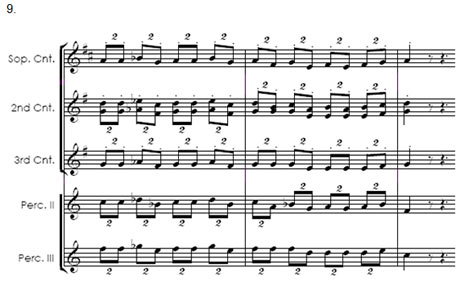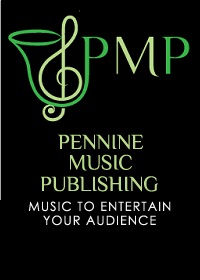Sleepless in Skegness? - Does PLC deserve a big city bonus with his latest test piece?
21-Jan-20104BR takes a forensic look at Paul Lovatt-Cooper's latest test piece. Is it a first class journey to some of the great global destinations, or just a clever musical pastiche of Whicker's World?
 It was mid way through 2009 when it was revealed that Paul Lovatt-Cooper’s ‘Sleepless Cities’ was to be the set work for elite bands at the Butlins Mineworkers Championships.
It was mid way through 2009 when it was revealed that Paul Lovatt-Cooper’s ‘Sleepless Cities’ was to be the set work for elite bands at the Butlins Mineworkers Championships.
There is no doubting that PLC’s effective style of composition has won him many fans all over the banding world. ‘Walking with Heroes’ has been one of the biggest CD sellers of the last few years, whilst there has been critical acclaim for his high profile contest works ’The Dark Side of the Moon’, ‘Skylines’ ‘Equilibrium’ and ‘Within Blue Empires’.
However, it is his ‘Sleepless Cities’ that has been stirring up great interest (and opinion) prior to the Butlins contest this weekend.
Background
The background to the piece lies with a composition written for Leeds Metropolitan University in 2008 entitled, ‘The Light Fantastic’ - a short concert work to celebrate the partnership between the University and Northern Ballet for their tour of China during the Olympic year.
The piece was subsequently re-edited by the media team at Leeds and used as the music to back their 2009 promotional campaign, renamed ‘Rubbing Shoulders with Champions’.
So how did we get from a short concert work in 2008 to a championship test piece for the Butlins Contest 2010?
Story
Paul gave 4BR the story behind the piece:
“When composing ‘The Light Fantastic’ I knew it was to be played throughout China, so I sketched thematic devices that followed the same principals as Gamelan and Eastern music.
I utilised repetitive consecutive 4th and 5th intervals, fusing them with a broad melodic line composed in the western tonal tradition.
This piece amalgamates both the Eastern and Western compositional styles and highlights the successful British and Chinese links forged by Leeds Met and Northern Ballet on their tour.
When working on the piece I began developing my material and sketching out more melodic and thematic ideas and experimenting with diverse musical genres. For ‘The Light Fantastic’ I was restricted with time, so on completion it became a concert work that was four minutes in duration.
However, I had an excess of additional musical ideas that I could have used in the piece if there were no time constraints.
I therefore took the advice of Peter Graham, who highlighted the age old process of composers re-using their own musical ideas - from JS Bach onwards.
With that in mind I started composing a more substantial work and used ‘The Light Fantastic’ and my additional musical material as a starting point.
The inspirational fulcrum was my own world-wide experiences, and so I started to compose a piece that was a musical postcard of all the various countries I have visited.
Towards the end of 2008 I was working with Stan Lippeatt and our conversation led onto my current compositional endeavours. I mentioned the piece and being a fan of my music he said he’d love to hear it, and that Butlins were looking to champion the work of the movement’s younger composers at a future contest.
I suggested submitting the work to be considered for inclusion at a future championship, and the rest as they say is ‘Sleepless Cities’.”
Analysis
Paul has given 4BR an in depth analysis of his work, which provides an illuminating insight into the musical and technical thought processes behind his composition.
And with all that information packed into his analytical suitcase, 4BR Editor, Iwan Fox, takes his own journey through some invigorating musical cityscapes.
‘Sleepless Cities’ is a demanding work that tests stamina, technique, dynamic range and the ability to play in musical styles not always linked with traditional brass band compositions.
The composer has alluded to musical styles linked with Arabic, Gamelan, Indian and modal writings, coupled with his flair for composing soaring melodies, pulsating rhythms and gripping excitement.
The piece is in essence in ternary form (section A, followed by a contrasting section B, returning with section A to conclude) with a slight dislocation occurring on reprise.
Section A:
The piece opens in the style of a traditional Indian ‘Raga’:

The tam tam strike at the beginning and roll on the timpani lead to the tambura like drone in the basses.
The ‘Raga’ theme is heard on the solo horn, which is imitated by the solo cornet, then baritone and finally, horns and baritones. With added decoration from the muted cornets and glockenspiel, the instruments play fragments of the ‘Raga’ that set the opening city scene.
Subsection 1
In a traditional ‘Raga’ the lead theme (which in most cases is the sitar) is followed by improvisation and embellishment over an underlying drone and a cyclic rhythmic pattern as the music develops.
In section A (the opening through to rehearsal figure R) PLC has incorporated this idea, but rather than embracing this idiom fully, he fuses it with various Eastern, Arabian and North African styles, linked to classic western tonal tradition.
As the music explores the various transformations from the original 12 note ‘Raga’, it splits into subsections, cleverly giving the listener the impression that each diversion represents a different eastern or middle eastern city.
There are no city identities written into the score, but the infusions are clear, allowing the listener to create their own images and cultural identities.
Subsection 2
The atmospheric opening (subsection 1) gives you a feeling of a sultry Indian morning, whilst the accelerando into subsection 2 takes us into the miasma of an unnamed Indian metropolis.
Fluctuating between the A flat harmonic and A flat melodic minor key, it starts with a relentless accompanying triplet quaver drive with the melodic line played by the solo cornets using components from the original ‘Raga’:

This develops with pulsating energy before a question and answer passage between the cornets and the horns take us to the first climatic passage at figure D, which moves away from the eastern musical influences of the harmonic and melodic minor key and bursts into a western sounding A flat major:

Using alternating sub-dominant and tonic chordal patterns, this eight bar reprise serves as an augmented cadence that underlines the tonal centre of this section.
Following on, the cornet plays the first technical solo of the piece with an ‘Arabic’ line derived from notes from the original ‘Raga’.
With sporadic interventions from the ensemble, a second soloist, the baritone, is heard; the melodic line developed from the cornet introduces the basses and euphoniums. We also hear soli melodic lines from baritones and euphoniums interrupted by splintered syncopated outbursts from the ensemble.
A shift in key at figure H and subito change in tempo gives the listener the impression of flying round the corner into another busy street.
However, this time you come to an abrupt halt almost as if local police blockade the road with resultant traffic jams and protesting locals!
The sextuplets in the upper brass and ensemble shock notes add to the commotion as the music pushes forward with a sense of urgency.
Eventually the music breaks free and moving up a key to C, the exploding timpani brings back the original ‘Raga’ theme.
With a pulsating triplet rhythmic accompaniment that shifts in semitone intervals, the trombones play the original ‘Raga’ theme at fortissimo, which modulates to F when joined by the horns and cornets.
Subsection 3
After this robust theme this subsection dies away, the key modulates back to B flat, leaving the trombones playing the ‘Raga’ as a canon, with open/closed harmon mutes in tow.
A rattlesnake in the form of a shaker/maraca, also joins the trombones in the new subsection 3, decorated with semiquavers from the original raga from the horns and cornets.
This new subsection highlights the change of mood, and with it a change of city – and a shift to the Middle East.
As the canon reconvenes to the tonic, the trombones and horns sustain the familiar drone as the euphonium plays a cadenza in the style of an Islamic ‘Call to Prayer’.
It is as if the Muezzin, a man appointed to call to prayer, climbs the minaret of the mosque, and commands – ‘Hasten to prayer’:

The cadenza builds and is joined by the decorated ‘Raga’ semiquavers in the horn and flugel. These runs are interrupted by shock notes in the muted cornets, played in the familiar interval of the 5th that lead into subsection 4.
Subsection 4
This new subsection at figure L has more of an Egyptian feel.
PLC still uses the notes from the ‘Raga’ but with a rhythmic pulse in the percussion, and the tambura like drone now in the muted cornets. It allows the middle of the band to play the ‘Raga’ but with fiery demi-semiquavers from the upper cornets, horns and baritones:

We also hear for the first time growing Asian influenced running semiquaver patterns in the cornets and percussion that utilise consecutive 4th and 5th intervals.
This motif starts to transform this section and gives the listener a taste of things to come:

During this ‘Egyptian’ subsection we hear a number of soloists showing their technical dexterity.
With the constant drone in the muted back row cornets and the rhythmic pulse from the basses and percussion we start with the trombone, followed by the E flat Bass and a trio of solo cornet, flugel and euphonium.
Subsection 5
The running semi quavers return again, but the rhythmic pulse in the basses and percussion keeps its relentless path firmly on the tonic of B flat minor.
However, the music shifts seamlessly into B flat major at rehearsal figure O and into subsection 5 which is the final city in this section.
We now hear a trademark PLC melodic line led by the euphonium accompanied by transposed running semi quavers and supported by a warm chord sequence.
We have clearly travelled away from the melodic and harmonic minor Middle Eastern musical motifs and have now planted our feet in the western hemisphere.
With running semi quavers, warm major chord sequences and flowing melodic material one can imagine flying over a city like New York or London at night, slowly taking in the sights and sounds accompanied by a warm summer breeze.
Section B
You could be fooled into thinking that ‘the nice PLC tune’ heard at the end of section A was just a pleasurable codetta to give the listener something to grasp onto after the unyielding 6 minutes or so of battling musical material.
However, that final subsection served as a bridge to this new contrasting section B that continues in the major key and is a fitting contrast to what has gone before.
The obvious links to the cities in section A serves as a stark contrast to the opening material heard here.
Material and inspiration
And the composer is very clear about this material, his inspiration and in linking the music to the title.
So what sleepless cities did he have in mind?
Paul told 4BR:
“For this middle section I ended up composing the musical material for this section after everything else.
My original idea was to compose some serene musical imagery from Japan where I visited last year. I was taken on a tour around the archaic buildings where ancient emperors lived and the sense of peace around the place was stunning.
However, it was outdone by my trip to Australia. I suffered from insomnia a great deal when I toured Australia and my body didn’t acclimatise at all the whole trip from the original jet lag. It was very exhausting, but it actually turned out to be a blessing in disguise.
“At sunrise when everybody else was sleeping at around 4 or 5am I was sat up staring through the curtains in my hotel room at the various cities we visited. Some of the sights I saw particularly in Melbourne, Perth and Sydney were awe inspiring.
Simple things from the sun breaking through the morning mist, birds singing and the stunning scenery and everywhere seemed so peaceful as well. That gave me the inspiration for this middle section of the piece.”
Section B
Section B starts at figure R with sustained notes from the cup-muted cornets and trombones. Each note entry – the tonic, dominant and the supertonic forms the suspended B flat chord that beams onto the City below. The tempo marking of Lento provides the timeless feel of a lazy sunrise at dawn.
The rising note clusters heard at Lento con Rubato before figure S in the cornets and trombones are imitated at S in the horns and baritones.
However, at figure S, the melodic motif undergoes a change to the brighter key of C major as the sun rises in the morning sky.
This section is in contrast to the music heard in section A. Even though the chords used are rich, with added 6th, 9th 11th and 12th notes, the musical colour that they portray is quite beautiful.
The dawn chorus (represented by the soprano) at bar 207 adds to the avian atmosphere, and the solo line will no doubt test the lyrical playing and phasing of the soloist.

More serene chord passages follow, before the main theme is introduced for this section, the texture broken by a rippling triplet figure.
This free counterpoint feature at figure T sits on a bass progression that develops to a perfect cadence into figure U, and introduces the main theme played by the solo cornet:

After the solo, the flugal joins and both instruments play the theme in unison, joined later by the horn and solo cornet 2 who add a counter melody.
The horns take over the melodic material at W that leads us into the main theme this time played in all its majesty by the full ensemble at figure X. A huge climax lands at bar 248, giving the listener the impression of terminus.
However PLC cleverly sidesteps this with an interrupted cadence and by dropping the dynamic to ‘piano’ to link this section to the finale.
Section A1
The final section completes the ternary form – with that touch of dislocation.
At figure Y we have a subito change in tempo and a change in time signature which takes us back to previous themes and motifs.
The pick-up from subsection 2 is featured in an eight bar motif at Y which modulates in the fifth bar. The recapitulation of this theme from subsection 2 (now in the new key of F) uses many of the same instrument voices to lead the solo lines.
The build into the climatic reprise at figure BB is not too dissimilar to that of the passage at figure D. However, because of the change of key, the falling semi quaver runs can be played in one continuous measure rather than splitting the octave leaps for each group of semis.
At CC the thematic device (heard originally at the start of subsection 2) now sounds again, but this time in the solo and flugel horn, whose questioning motifs are answered by the xylophone and glockenspiel.
It sounds again for the second time at rehearsal figure DD, but this time the questions posed gain varied answers, as in the soprano and back row cornets as well as the xylophone and glockenspiel.
The answer this time uses the consecutive running 4ths and 5ths featured in subsection 4 but with the differing tempo it is augmented into running duplet quavers.

This serves as the backbone to the finale that not only utilises material from the opening of the piece but also gives a sense of musical wholeness by joining material with the main theme from section B of the work.
With the finale section bringing together the main western styled theme and mixing it with the eastern influences found in the opening section, the momentum and excitement builds to a pulsating close.
Conclusion
In conclusion you have a piece of music that not only stands as a good test for a top section contest, but is also a piece that could be performed with success on the concert platform too.
There is a huge amount of detail that the conductors need to draw from the score and creating a successful balance in the ensemble parts will be paramount.
The technical passages will create minefields of apprehension for both soloists and ensemble, whilst running at a good fifteen minutes, stamina will be a big factor too. It is a bit of a lip buster.
As you would expect, ‘Sleepless Cities’ is a test piece with a fresh look and feel. It doesn’t over indulge in the ‘too different’, as we have plenty of the usual PLC emotion and excitement, but it will certainly get people possibly revising their preconceptions of a piece that has emerged from varied sources.
Iwan Fox















